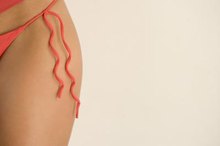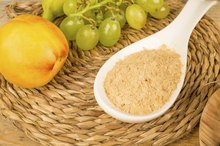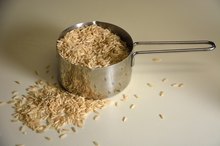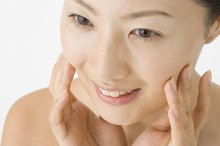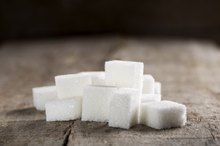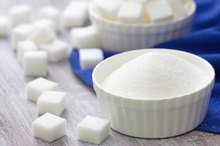What does fact checked mean?
At Healthfully, we strive to deliver objective content that is accurate and up-to-date. Our team periodically reviews articles in order to ensure content quality. The sources cited below consist of evidence from peer-reviewed journals, prominent medical organizations, academic associations, and government data.
The information contained on this site is for informational purposes only, and should not be used as a substitute for the advice of a professional health care provider. Please check with the appropriate physician regarding health questions and concerns. Although we strive to deliver accurate and up-to-date information, no guarantee to that effect is made.
Glycerin & Yeast Infections
More than 75 percent of women will acquire at least one yeast infection in their lives, according to Assistant Professor of Obstetrics and Gynecology at Harvard Medical School Joan Bengtson, M.D. There are many causes, but the main reason for a yeast infection is the vaginal environment becoming upset, causing a disruption in the pH and an overgrowth of the normally present yeast. One of the common culprits in causing this disruption is sugar, and recently experts have linked glycerin, a general additive in processed foods, beverages and cosmetics, to posing problems in women already prone to yeast infections.
If you are experiencing serious medical symptoms, seek emergency treatment immediately.
Yeast Infections
Yeast infections are an overgrowth of yeast, a fungus called Candida albicans, in the vagina. It is normally present in small amounts, but with a disruption of the pH the yeast rapidly produces, causing the varying symptoms of a red, itchy, burning, painful vaginal area with a heavy discharge. There are many reasons for getting a yeast infection including antibiotics, birth control pills, pregnancy, stress, lack of sleep, normal hormonal shifts in the menstrual cycle and eating too many sugary foods. Yeast infections can be cured by over-the-counter medications or prescribed one-time pills, and in addition, many women believe in various home remedies.
- Yeast infections are an overgrowth of yeast, a fungus called Candida albicans, in the vagina.
- It is normally present in small amounts, but with a disruption of the pH the yeast rapidly produces, causing the varying symptoms of a red, itchy, burning, painful vaginal area with a heavy discharge.
Glycerin
How to Get Rid of Vaginal Odor Without Going to the Doctor
Learn More
Glycerin is used to provide preservation and sweetness to many processed foods, including low-fat commercially baked foods, candy and fudge. It is also used in cosmetics and personal lubricants to provide preservation and for its humectant qualities, used to draw moisture to the skin. It is derived from the chemical element glycerol, an alcohol, and glycerin is the byproduct of either animal or plant sources. (In the 1800s when candles were made of animal fat, glycerin was a byproduct of candle-making.)
- Glycerin is used to provide preservation and sweetness to many processed foods, including low-fat commercially baked foods, candy and fudge.
- In the 1800s when candles were made of animal fat, glycerin was a byproduct of candle-making.)
Avoid Glycerin in Foods
To help avert yeast infections, many gynecologists advise staying away from a diet rich in refined sugar. Yeast in the vagina feed off of sugar, so any access to excess sugar provides a possible food source for the already present yeast. Not only is too much sugar a risk for yeast infections, but it is also hard for the body to digest and can lead to obesity, diabetes and heart disease. Sugar can be found in more places than people think; all-purpose enriched wheat flour is one of the most common ingredients in commercially processed foods. The “wheat” in this ingredient is only part of the actual grain, the part that breaks down in the body exactly as raw sugar. Whole-wheat flour and products are best for avoiding yeast infections and for overall health.
- To help avert yeast infections, many gynecologists advise staying away from a diet rich in refined sugar.
- Yeast in the vagina feed off of sugar, so any access to excess sugar provides a possible food source for the already present yeast.
Avoid Glycerin in Lubricants
Relief for External Vaginal Itch
Learn More
Many gynecologists warn if women are already susceptible to recurring yeast infections, they should steer clear of personal lubricants containing glycerin. Since it is processed exactly as sugar in the body, and applied directly to the vagina, it is assumed vaginal yeast benefits from its addition. If women do not get frequent yeast infections experts say using lubricants with glycerin is okay; KY Jelly, the No. 1 brand in America, is full of glycerin. Some people may be more sensitive to glycerin’s effects than others. Glycerin is found in most water-based lubricants, but there are some water-based brands free of glycerin. The other choice, silicone-based lubricants, do not contain glycerin, but many complain about the bad taste and dislike their resistance to water for cleaning.
- Many gynecologists warn if women are already susceptible to recurring yeast infections, they should steer clear of personal lubricants containing glycerin.
- The other choice, silicone-based lubricants, do not contain glycerin, but many complain about the bad taste and dislike their resistance to water for cleaning.
Glycerin-Free Lubricants
Although the popular brand KY contains glycerin, other big brands like Astroglide make a glycerin-free version. Simply check the ingredients listed on the back of water-based lubricants for glycerin.Natural lubricants that have stood the test of time are extra virgin olive oil and coconut oil.
Related Articles
References
- Planned Parenthood. What is a yeast infection?
- InformedHealth.org [Internet]. Cologne, Germany: Institute for Quality and Efficiency in Health Care (IQWiG); 2006-. Vaginal yeast infection (thrush): Overview. 2019 Jun 19.Available from: https://www.ncbi.nlm.nih.gov/books/NBK543220/
- Singh A, Verma R, Murari A, Agrawal A. Oral candidiasis: An overview. J Oral Maxillofac Pathol. 2014;18(Suppl 1):S81–S85. doi:10.4103/0973-029X.141325
- Jeanmonod R, Jeanmonod D. Vaginal Candidiasis (Vulvovaginal Candidiasis) [Updated 2020 Feb 4]. In: StatPearls [Internet]. Treasure Island (FL): StatPearls Publishing; 2020 Jan-. Available from: https://www.ncbi.nlm.nih.gov/books/NBK459317/
- InformedHealth.org [Internet]. Cologne, Germany: Institute for Quality and Efficiency in Health Care (IQWiG); 2006-. Oral thrush: Overview. 2012 Apr 26 [Updated 2019 Aug 15].Available from: https://www.ncbi.nlm.nih.gov/books/NBK367586/
- Blostein F, Levin-sparenberg E, Wagner J, Foxman B. Recurrent vulvovaginal candidiasis. Ann Epidemiol. 2017;27(9):575-582.e3. doi:10.1016/j.annepidem.2017.08.010
- Aguin TJ, Sobel JD. Vulvovaginal candidiasis in pregnancy. Curr Infect Dis Rep. 2015;17(6):462. doi:10.1007/s11908-015-0462-0
- Rajalakshmi R, Kalaivani S. Prevalence of asymptomatic infections in sexually transmitted diseases attendees diagnosed with bacterial vaginosis, vaginal candidiasis, and trichomoniasis. Indian J Sex Transm Dis AIDS. 2016;37(2):139–142. doi:10.4103/0253-7184.192121
- Ringdahl EN. Treatment of recurrent vulvovaginal candidiasis. Am Fam Physician. 2000;61(11):3306-12, 3317.
- Aguin TJ, Sobel JD. Vulvovaginal candidiasis in pregnancy. Curr Infect Dis Rep. 2015 Jun;17(6):462. doi: 10.1007/s11908-015-0462-0.
- Blostein F, Levin-Sparenberg E, Wagner J, Foxman B. Recurrent vulvovaginal candidiasis. Ann Epidemiol. 2017 Sep;27(9):575-582.e3. doi: 10.1016/j.annepidem.2017.08.010.
- Chew SY, Than LT. Vulvovaginal candidosis: contemporary challenges and the future of prophylactic and therapeutic approaches. Mycoses. 2016 May;59(5):262-73. doi: 10.1111/myc.12455.
- Roberts CL, Algert CS, Rickard KL, Morris JM. Treatment of vaginal candidiasis for the prevention of preterm birth: a systematic review and meta-analysis. Syst Rev. 2015 Mar 21;4:31. doi: 10.1186/s13643-015-0018-2.
- Xie HY, Feng D, Wei DM, Mei L, Chen H, Wang X, Fang F. Probiotics for vulvovaginal candidiasis in non-pregnant women. Cochrane Database Syst Rev. 2017 Nov 23;11:CD010496. doi: 10.1002/14651858.CD010496.pub2.
Writer Bio
Annie Tumlin is based in Overland Park, Kan., and has been writing since 2002. She contributes to various websites, including the blog for a fitness studio, specializing in parenting, pregnancy, health and wellness. Tumlin holds a Bachelor of Arts in education and English from Rockhurst University, and has worked in various education settings.
